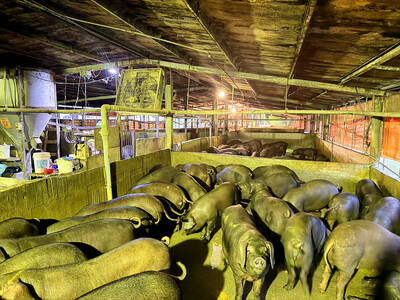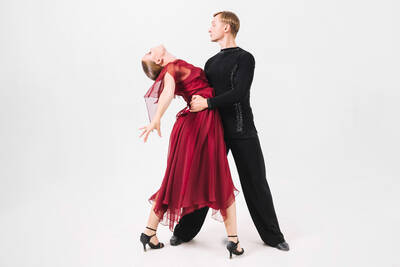“Gymnast genie” Ting Hua-tien turned 17 on Oct. 11, and has just received a belated birthday gift. She has officially been awarded accreditation by the Federation Internationale de Gymnastique (FIG, International Federation of Gymnastics) for a modified gymnastics move, given a “D” level of difficulty and named after her. Ting is the first Taiwanese to have ever achieved this.
There have been previous attempts by Taiwanese gymnasts to have moves they have developed named after them. Lin Hsiang-wei has tried to register the “Lin Hsiang-wei turn” on the pommel horse and “Pommel Horse King” Lee Chih-kai this year also applied. Unfortunately, in the end neither attempt proved successful.
Ting performed her new move for the first time in an international competition at this year’s Artistic Gymnastics World Cup in Melbourne. Since the move was a modified element of a longer routine, Ting was the first person in the world to actually perform it, and coach Tsai Heng-cheng decided to apply for it to be named after Ting before anyone else could do so, so that its level of difficulty could be reflected in the scoring.

Photo: Lin Cheng-kung, Liberty Times
照片:自由時報記者林正堃攝
After a long wait, the FIG finally officially announced that the move would be written into the history books as the “Ting Hua-tien move.” Now gymnasts from around the world can start applying the move in their routines in competitions.
According to Tsai, “The Ting Hua-tien routine is an extension of an original move, and I thought she performed it particularly well and that we could use it in international competitions. Then, during the Asian Championships one of the judges suggested that we apply for it to be named after her, and now it has been officially recognized, and become another element for us to include.”
Ting has made a name for herself in Taiwanese gymnastics this year: in addition to having a move named after her, she also qualified in this year’s 2019 World Artistic Gymnastics Championships for the Tokyo Olympics, making her the first Taiwanese female gymnast in 51 years to qualify for the games.

Photo courtesy of Tsai Heng-cheng
照片:蔡恆政教練提供
(Translated by Paul Cooper, Taipei Times)
體操精靈」丁華恬在十月十一日滿十七歲,近日終於收到遲來的生日大禮,憑藉改良後的地板動作,正式獲國際體操總會認可,未來有一D難度動作以「丁華恬」為名,成為台灣第一人。
台灣過去有多名選手開發新動作並申請命名,鞍馬好手林祥威以「林祥威轉體」及聲勢如日中天的「鞍馬王子」李智凱在今年進行申請,可惜兩人最終未能如願寫下歷史。
丁華恬在今年世界盃墨爾本站首次在國際賽展現新動作,即使該動作屬透過改良並延伸出的另種套路,正好是世界第一位使用的選手,為了讓動作難度被承認及加分,教練蔡恆政才決定搶先申請命名。
經過許久等待,FIG近日終於正式公告確定「丁華恬」為名之動作能在歷史留名,目前各國選手也有人開始採「丁華恬」動作進行比賽。
蔡恆政透露:「丁華恬這套動作是從原有動作進行延伸,起初只想說做起來不錯,也能在國際賽使用,而當時在澳洲大獎賽有裁判建議我們申請命名,最後確定獲總會認證,成為意外的插曲。」
丁華恬是今年台灣體操最風光的女將,除了動作獲認可及命名,她在今年世錦賽搶下台灣相隔51年首張奧運女子體操入場券。
(自由時報)

For many people in Taiwan, childhood memories of rural life include pig pens standing beside family homes. Leftover rice, vegetable scraps and soup from daily meals were poured into buckets and fed to pigs. This practice of feeding pigs with household food waste was once a common way of life, both an economic choice and an expression of agricultural society’s deep respect for conserving resources. From a practical standpoint, pigs are omnivorous animals capable of efficiently digesting food scraps that humans can no longer eat. For rural households, food waste cost almost nothing, yet it could be converted into pork, a

A: Apart from the Taipei Music Center’s exhibit and concert, US pop rock band OneRepublic and rapper Doja Cat are touring Kaohsiung this weekend. B: OneRepublic is so popular that after tonight’s show at the K-Arena, they are set to return to Taiwan again in March next year. A: And Doja will also perform at the same venue on Sunday, right? B: Yup. Her collab with Blackpink’s Lisa and singer Raye for the song “Born Again” has been a huge worldwide success. A: Doja even made it on Time magazine’s “100 Most Influential People” list in 2023. She’s so cool. A: 本週末除了北流的特展和演唱會外,美國男團共和世代和饒舌歌手蜜桃貓朵佳也將來台開唱。 B: 共和世代因太受歡迎,繼今晚高雄巨蛋的演唱會後,預計明年3月即將再度來台巡演唷。 A: 朵佳本週日將在同場地開唱,對不對?

Tango unfolds in a dimly lit room, where a haunting melody ushers two dancers into a close embrace. Here, music and movement merge into a silent yet passionate conversation, expressing longing, memory and shared purpose. What makes tango truly magical is the deep interaction and spontaneous improvisation between partners. Tango began in the late 19th century in Buenos Aires, Argentina’s bustling capital. Born in the poor working-class neighborhoods and busy port areas, this dance emerged from a melting pot of cultures. European immigrants, African slaves and local residents all contributed to its unique character. From these rich influences, tango

A: What show are you watching online? B: I’m watching “Fly Me to the Moon & Back” – an exhibition launched by the Taipei Music Center (TMC) to commemorate the late singer Tom Chang. A: Known for his sky-high notes, Chang is praised as one of the best singers in the 1990s. His death at the age of 31 was a major loss indeed. B: And I’m so glad that we went to the TMC’s 90s-themed concert last Friday. I finally saw the iconic “Godmother of Rock” WaWa perform live. A: This year-end show also featured singers Princess Ai, Bii, Wayne Huang, PoLin and